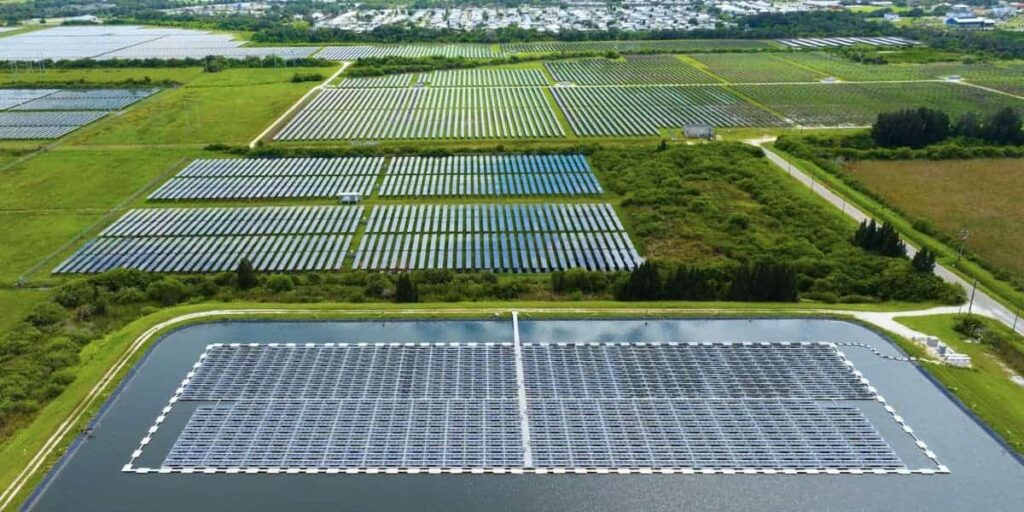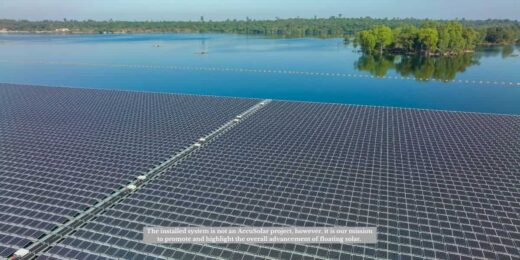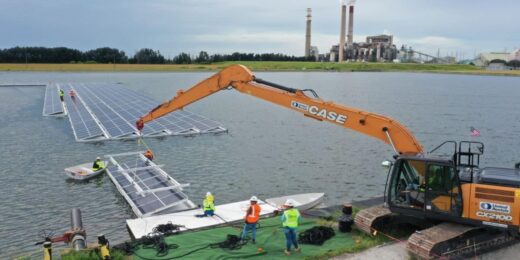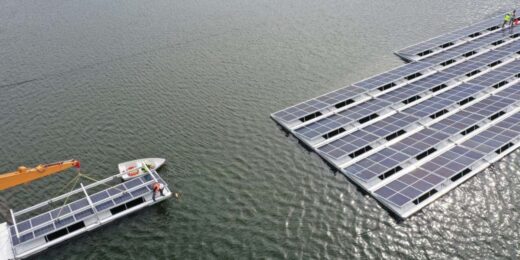Solar power has become one of the most exciting success stories of the 21st century. Just a decade ago, renewable energy was considered expensive and experimental. Today, it’s breaking records and reshaping how nations generate electricity. But as demand for solar explodes, so does the question: where do we put all those panels?
Traditionally, ground mounted solar systems on rooftops and fields dominated. Now, with land growing scarcer and pricier, floating solar on reservoirs, lakes, and ponds is turning water bodies into clean energy hubs.
Which technology wins: the tried-and-true land array or the innovative floating farm?
This blog will dive into a head-to-head comparison across the most crucial categories: Efficiency, Cost, and Environmental Impact. We’ll also examine future trends and provide a clear recommendation for different scenarios.
Efficiency: How Much Energy Can They Deliver?
Land-Based Solar (Ground-Mounted)
Ground mounted solar systems have been the industry’s backbone for decades. These setups place panels on racking structures tilted toward the sun. In many cases, single-axis trackers allow panels to follow the sun across the sky, squeezing out up to 25% more energy than fixed systems.
Real-world examples show how effective this can be. In California’s Central Valley, for instance, massive land-based farms produce hundreds of megawatts of electricity, feeding directly into the grid. Their efficiency comes not only from the panels but also from optimal siting, orientation, and technology improvements.
Land-based solar does present several obstacles. Primarily, panels situated over soil or grass become hotter than panels over water. This is a critical factor because higher heat reduces efficiency, a temperature increase of just 1∘C above the panel’s optimal temperature can cause an efficiency drop of approximately 0.5%. Airborne debris such as dust from storms, agricultural activity, or even wind-blown soil can accumulate on panels, significantly reducing power output unless they are cleaned frequently.
The water-cooling benefit has made floating solar increasingly popular across major water bodies, where panels achieve 5-15% better performance than comparable land-based systems.
Pros of Ground Mounted Solar Systems
- Established Technology and Expertise
- Proven Longevity and Durability
- Easier Maintenance and Accessibility
- Optimal Angle and Orientation
Cons of Ground Mounted Solar Systems
- Dust and debris accumulation require frequent maintenance
- Large footprints can make them impractical in dense areas
- Environmental Impact on Land
- Aesthetics and Zoning
Floating Solar Systems
Floating solar panels offer a natural advantage because the water beneath them acts as a built-in cooling system. Studies conducted in Japan, China, and India show that panels floating on reservoirs often perform 5–15% better than comparable land-based systems. This is because the water helps keep the panel temperatures stable, preventing the efficiency losses that typically occur on hot days. This benefit has made floating solar increasingly popular in the U.S. An additional benefit comes from reflection, or albedo. Light that bounces off the water’s surface can be captured by the panels, providing a slight increase in energy generation.
Floating solar offers major system benefits in hybrid projects. A prime example is the Cirata Floating Solar Farm in Indonesia. By pairing 145 MW of floating panels with existing hydropower infrastructure, the project achieves a seamless energy balance. The solar generates electricity during the day, and the hydropower facility smooths the output curve, guaranteeing power stability at night or in challenging weather. This strategic integration makes the entire system significantly more efficient.
Pros of Floating Solar Systems
- Increased Energy Output
- Reduced Water Loss from Evaporation
- Improved Water Quality and Reduced Algae Growth
- Land Conservation
- Easy Integration to Existing Infrastructure
- Lower Operations and Maintenance Costs
- Environmental Benefits
Cons of Floating Solar Systems
- Installation is more complex, often requiring a multi-stage process
- Requires specialized floats designed to withstand dynamic water conditions and specific load requirements
- Suitability varies among bodies of water
Which Option Fits the Budget?
When it comes to dollars and cents, mounted solar panels on land have a strong head start. They’ve benefited from decades of falling panel prices, streamlined supply chains, and well-understood financing. According to the International Renewable Energy Agency (IRENA), utility-scale land solar is now among the cheapest energy sources in history, with costs falling by more than 80% in the last decade.
But costs aren’t uniform. Land availability and price play a huge role. In rural Arizona or Nevada, wide open desert makes land solar inexpensive. In crowded parts of Europe or Asia, however, land is scarce, and competition with housing or farming pushes prices up.
Floating solar, by contrast, avoids land battles altogether. By placing mounted solar panels on reservoirs, water treatment ponds, or retention basins, developers sidestep costly land leases and zoning debates. For municipalities with underused water surfaces, this can be a win-win.
Still, the floats, anchoring systems, and waterproof cabling are specialized, and specialized means expensive. Floating solar often carries a 10–20% premium over land-based projects today. That gap is shrinking as manufacturers scale up and competition increases, but for now it remains a hurdle.
One way floating solar reduces cost is by sharing infrastructure. For example, projects near hydropower dams can plug into existing grid connections, avoiding the need to build new transmission lines. Over the system’s lifetime, lower maintenance from reduced dust and dirt may also offset higher upfront costs.
Which Leaves a Lighter Footprint?
There’s no doubt that land-based solar is far cleaner than fossil fuels, but its footprint on ecosystems is real. Large farms can displace wildlife habitats or take land out of agricultural use. In the Mojave Desert, for instance, large solar farms sparked controversy because they disturbed desert tortoise habitats.
On the positive side, many land-based projects now target brownfields, abandoned mines, or industrial lots — spaces unsuitable for farming or housing. This repurposing reduces environmental conflict and turns otherwise wasted land into clean energy hubs.
California researchers estimate that widespread deployment of solar panels over water infrastructure could save billions of gallons of water annually if applied to reservoirs and canal systems statewide.
Pros of Ground Mounted Solar Systems
- Can revitalize degraded or abandoned land
- Cuts greenhouse gas emissions dramatically
- Permitting frameworks are well established
Cons of Ground Mounted Solar Systems
- May compete with farmland or housing
- Land clearing can cause erosion or habitat loss
- Potential public opposition in sensitive areas
Floating solar avoids land conflicts by making use of existing water bodies. A project in Portugal’s Alqueva Reservoir, for example, combines hydropower with floating solar to maximize renewable generation without touching farmland.
Beyond saving land, floating solar helps save water. By shading reservoirs, mounted solar panels reduce evaporation critically in regions facing water scarcity. In California, researchers estimate floating solar could save billions of gallons of water annually if deployed widely on reservoirs. Floating systems also reduce algae growth by shading parts of the water surface, improving water quality for irrigation or drinking.
Still, floating solar’s long-term ecological impacts remain under study. Some researchers are examining how shading affects aquatic ecosystems, fish behavior, and oxygen levels. So far, early findings suggest impacts are manageable, especially with careful siting and monitoring.
Pros of Floating Solar Systems
- Doesn’t compete with farmland or natural habitats
- Reduces evaporation and conserves water
- Can improve water quality by curbing algae growth
Cons of Floating Solar Systems
- Anchoring and installation may disturb sediments
- Permitting frameworks are less mature than those for land solar
Future Outlook: What’s Next?
The future of solar energy is not about replacing one technology with another but about weaving together complementary solutions. Both ground-mounted and floating solar have distinct strengths, and the global transition to renewable energy will require a combination of both.
The burgeoning floating solar industry demonstrates multiple advantages beyond energy generation, including water conservation, land preservation, and enhanced grid stability when paired with hydropower.
Hybrid Systems and Grid Stability
Hybridization is a growing trend. Pairing floating solar with hydropower, as seen in projects in Southeast Asia, demonstrates how renewables can complement one another. Hydropower dams already have reservoirs, transmission lines, and substations in place, making them prime candidates for floating solar. This synergy reduces the need for additional land and cuts project costs while ensuring reliable, round-the-clock energy production.
Technology Innovation and Cost Reductions
The burgeoning floating solar industry is mirroring the rapid cost reduction seen in traditional mounted solar panels over the last decade. As new companies join the market, the corresponding expansion of supply chains is driving down the prices for critical components like floats, anchoring systems, and waterproof cabling. The development of modular, scalable designs is simplifying and accelerating installations for municipalities, utilities, and private developers. It’s anticipated that floating solar will eventually achieve cost parity with land-based solar, especially in regions where suitable land is scarce.
Policy and Regulatory Growth
Government policies are another accelerant. Nations like India, Japan, and China have embraced floating solar as part of their renewable energy strategies. The U.S. and Europe are catching up, with pilot projects underway and policy discussions focused on unlocking reservoirs and industrial water bodies for solar development. Permitting frameworks are still developing, but as success stories accumulate, governments are likely to streamline approval processes and incentivize floating solar installations.
The Global Potential
The opportunity is massive. The World Bank estimates that covering just 10% of the world’s man-made reservoirs with floating solar could generate as much electricity as all fossil fuel power plants currently operating worldwide. That’s not a niche solution; it’s a potential game-changer for energy security, climate resilience, and water conservation. For countries struggling with land scarcity or rapid urbanization, floating solar could be the key to meeting clean energy targets without sacrificing agriculture or housing.
In short, floating solar is no longer a niche experiment. It’s on track to be one of the defining technologies of the energy transition.
Choosing the Right Option
Deciding between land-based and floating solar isn’t about declaring one the “winner.” Instead, it’s about matching the right technology to the right context.
Urban or Land-Scarce Regions → Floating Solar
For crowded cities or nations with limited open land, floating solar unlocks untapped resources. By transforming reservoirs, canals, or even abandoned mining pits into clean energy hubs, floating solar provides power without disrupting housing or food production.
Agricultural Communities → Floating Solar to Protect Farmland
In areas where farmland is precious, floating solar prevents competition between food and energy. Farmers can continue to use their land, while nearby reservoirs or irrigation ponds host panels. At the same time, reduced evaporation helps conserve water for crops.
Utilities and Hydropower Operators → Hybrid Floating-Hydro Systems
Utilities with access to reservoirs or hydropower infrastructure stand to benefit the most. Floating solar reduces costs by using existing grid connections, while hydro dams help balance the grid when the sun isn’t shining.
Rural Areas with Abundant Land → Ground-Mounted Solar
In wide-open rural or desert regions, land-based solar remains king. It’s still the most cost-effective, easiest-to-finance option where land is cheap and abundant.
Risk-Averse Investors → Ground-Mounted Solar for Bankability
For investors seeking security, ground-mounted solar provides a track record of decades of predictable returns. Floating solar, though promising, is still newer and may take a few more years to achieve the same level of investor comfort.
The debate between land-based vs. floating solar doesn’t need a single champion. Land-based solar is the reliable veteran — tested, affordable, and widely deployed. Floating solar is the rising star — efficient, innovative, and particularly valuable in regions facing land and water challenges. Together, they can drive the global renewable transition forward faster than either could alone.
Ground Mounted Solar Systems and Mounted Solar Panels: Building a Clean Energy Future
The accelerating global clean energy transition demands more than a single solution—it requires a diverse portfolio. The smartest path forward is not “either-or” but “both-and.” Ground mounted solar systems will remain the dominant, cost-effective option where space is plentiful. Floating solar is the key to unlocking new capacity in markets constrained by population density, land-use conflicts, and climate stress.
By integrating both technologies, we move beyond asking “which is better” to asking “how do we maximize both?” This powerful “one-two punch” allows nations to expand renewable capacity faster, conserve land and water resources, and build a cleaner, more resilient energy future. Whether choosing traditional ground mounted solar systems or innovative floating arrays, the strategy balances cost-effectiveness with innovation and sustainability.
At AccuSolar, we’re leading the charge in the clean energy transition. We design, engineer, and deliver American-made floating solar solutions that help communities, utilities, and businesses harness the full potential of renewable power. From custom floating platform engineering to complete system installation, we provide tailored solutions for challenging sites.
Ready to unlock your clean energy potential? Whether you’re considering ground mounted solar systems, mounted solar panels, or floating arrays, contact us to start designing a solution for your project and help shape the future of renewable power.
This article was originally published on July 19th, 2022 and has been updated on October 21, 2025 to provide the most accurate and relevant information.





